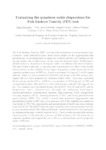Use este identificador para citar ou linkar para este item:
http://www.alice.cnptia.embrapa.br/alice/handle/doc/1068204Registro completo de metadados
| Campo DC | Valor | Idioma |
|---|---|---|
| dc.contributor.author | CLEMENTE, Z. | pt_BR |
| dc.contributor.author | CASTRO, V. L. S. S. de | pt_BR |
| dc.contributor.author | FRANQUI, L. | pt_BR |
| dc.contributor.author | SILVA, C. A. | pt_BR |
| dc.contributor.author | MARTINEZ, D. S. T. | pt_BR |
| dc.date.accessioned | 2017-04-06T11:11:11Z | pt_BR |
| dc.date.available | 2017-04-06T11:11:11Z | pt_BR |
| dc.date.created | 2017-04-06 | pt_BR |
| dc.date.issued | 2016 | pt_BR |
| dc.identifier.citation | In: ENCONTRO ANUAL DA SOCIEDADE BRASILEIRA DE PESQUISA EM MATERIAIS, 15., 2016, Campinas. [Abstracts...] Rio de Janeiro: Sociedade Brasileira de Pesquisas em Materiais, 2016. Resumo B6E2. | pt_BR |
| dc.identifier.uri | http://www.alice.cnptia.embrapa.br/alice/handle/doc/1068204 | pt_BR |
| dc.description | The Fish Embryo Toxicity (FET) test has wide utilization in nanoecotoxicology. However, some difficulties have been found related to the aggregation and precipitation of nanomaterials in exposure medium and the contrasting results among studies due to differences in the material characteristics. Furthermore, abiotic factors as the presence of organic matter can influence the test evaluation. The aim of this study was to evaluate and characterize the effect of the humic acid presence in the stability of two types of graphene oxide dispersion in an exposure medium used in FET test. Stock-suspensions (1.0 mg mL-1) of GO (sigma Aldrich, flakes) or base-washed GO (bwGO) and humic acid (HA sodium salt, Sigma Aldrich) were prepared in ultrapure water (UW). They were sonicated before preparing the GO or bwGO test suspensions at 100.0 µg mL-1 in UW and reconstituted water (RW, pH 8±0.2, 425±129 µS/cm), with HA (20.0 µg mL-1)or not. The samples were incubated during 96h at 26oC. The GO and bwGO and its dispersions were characterized through the following techniques: spectrophotometry, centrifugation, dynamic light scattering (DLS), nanoparticle tracking analysis (NTA), thermogravimetry (TGA), and X-ray photoelectron spectrometry (XPS). The results showed that materials aggregated and precipitated quickly in RW, but in the presence of HA the stability was similar to that found in UW. The aggregation and precipitation of bwGO was more intense than that of GO. The bwGO showed a great particle sizes heterogeneity than GO, in any condition tested. The different behavior can be related to the less presence of oxygenated groups in bwGO regards to GO. These results showed that surface characteristic of GO and the presence of HA influence the GO behavior in exposure medium and support the use of HA as a natural dispersant to graphene oxide in FET test. | pt_BR |
| dc.language.iso | por | pt_BR |
| dc.rights | openAccess | pt_BR |
| dc.subject | FET test | pt_BR |
| dc.subject | Ecotoxicologia | pt_BR |
| dc.title | Evaluating the graphene oxide dispersions for fish embryo toxicity (FET) test. | pt_BR |
| dc.type | Resumo em anais e proceedings | pt_BR |
| dc.date.updated | 2017-08-01T11:11:11Z | pt_BR |
| dc.subject.thesagro | Peixe | pt_BR |
| dc.subject.nalthesaurus | Graphene | pt_BR |
| riaa.ainfo.id | 1068204 | pt_BR |
| riaa.ainfo.lastupdate | 2017-08-01 | pt_BR |
| dc.contributor.institution | ZAIRA CLEMENTE, CNPEM; VERA LUCIA SCHERHOLZ S DE CASTRO, CNPMA; LIDIANE FRANQUI, CNPEM; CRISTIANE A. SILVA, CNPEM; DIEGO STEFANI TEODORO MARTINEZ, CNPEM. | pt_BR |
| Aparece nas coleções: | Resumo em anais de congresso (CNPMA)  | |
Arquivos associados a este item:
| Arquivo | Descrição | Tamanho | Formato | |
|---|---|---|---|---|
| 2016RA041.pdf | 49,73 kB | Adobe PDF |  Visualizar/Abrir |









